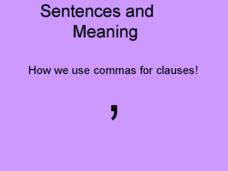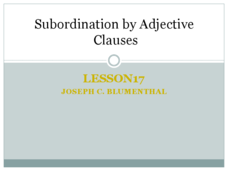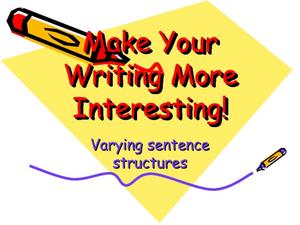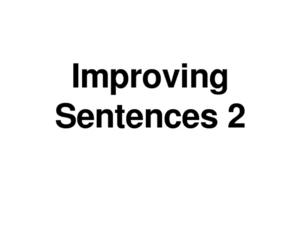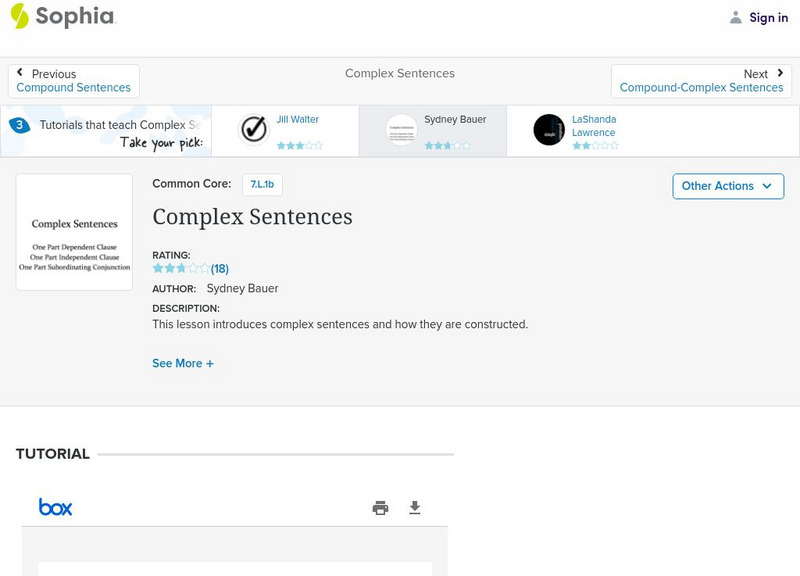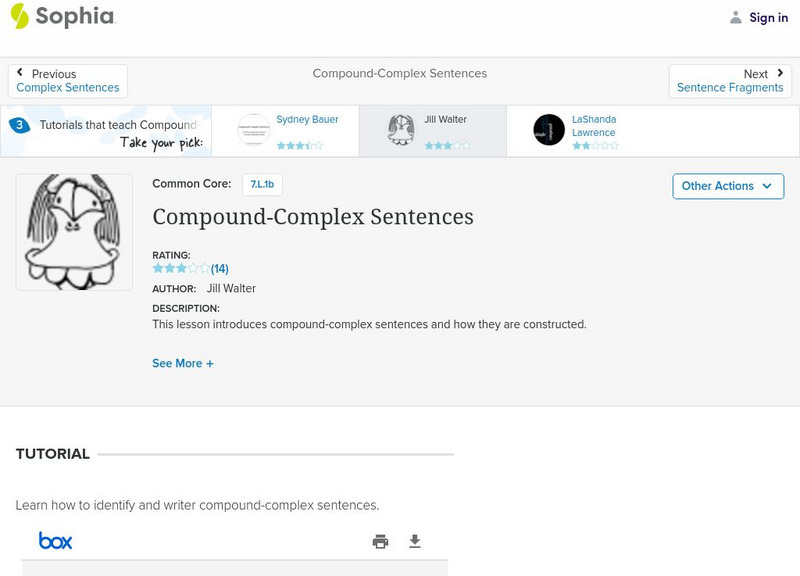Curated OER
Creating Complex Sentences
Here is an excellent presentation on creating complex sentences. Young writers discover that a complex sentence is a sentence that joins two or more sentences together. There are many ways for these types of sentences to be constructed,...
Curated OER
Simple, Compound, and Complex Sentences
Discuss simple, compound, and complex sentences using this resource. Using a series of examples, learners talk about the characteristics of these types of sentences. This is a quick and easy way to cover this topic.
Curated OER
Simple, Compound, Complex, and Compound-Complex Sentences in Your Writing
Encourage your young writers to make their writing more interesting by varying their sentence structures. Each color-coded slide offers definitions and models of sentence forms. The final slide in the presentation presents viewers with...
Curated OER
How we use Commas for Clauses!
Commas can be tricky to use and can also greatly affect sentence meanings. Use this wonderful PowerPoint to remind your class when it is appropriate to use a comma. The last slide includes sentence samples for practice.
Curated OER
Subordination by Adjective Clauses
A must-see for teachers who are tired of reading essays full of simple sentences, this thorough and engaging presentation teaches students to subordinate independent clauses by turning them into adjective clauses. Don't be discouraged by...
Curated OER
Compound-Complex Sentences
What is a simple sentence? What about a complex sentence? Review simple, compound, and complex sentences with this nine-slide resource. Example sentences are presented, and a short writing opportunity follows. After showing this...
Curated OER
The Sentence
Introduce learners to the wonders and variations found in sentence writing. Several sentence types are defined and exemplified in each slide. Simple, complex, and compound sentences, as well as coordination and subordination are all...
Curated OER
Make Your Writing More Interesting
Teach your class how to improve their writing. This resource walks learners through the keys to good writing. It addresses the need for complex sentences, the use of different ways to open a sentence, and the importance of varying the...
Curated OER
Sentence Construction: What is a Sentence?
What must a sentence contain in order to be complete? What different types of sentences exist? Look at declarative, interrogative, and exclamatory sentences with this 17-slide presentation. Several example sentences are shown, and the...
Curated OER
Complex Sentences
Review the parts of a sentence! This short slide show describes simple, complex, and compound sentences. Examples of each are shown, and on the final slide, viewers finish five dependent clauses to create complete sentences.
Curated OER
Varying Sentence Structure
Show your writers how to use simple, compound, and complex sentences to add variety to writing. In addition, examples show how to employ semicolons and coordinating conjunctions to combine sentences. Colorful illustrations and graphics...
Curated OER
Improving Sentences 2
Looking for a good presentation which teaches how to write higher-level sentences? Then, this one is for you! Learners are shown how to expand their sentences by using connectives, adding clauses, and how to appropriately use commas to...
Curated OER
Sentence Structure: Sentence Types
Sixth graders identify parts that make up different types of sentences with a grammar presentation. The last few slides prompt learners to complete 10 exercises in which they indicate whether each sentence is simple, compound,...
Pearson
Future Time Clauses
What will you do when you grow up? What are you going to do after school is over? Learn about future time clauses and how they connect to independent clauses with a helpful grammar presentation.
Curated OER
Clauses and Sentences
Review sentence structure using this presentation. Learners identify complete and incomplete sentences. Then, they read a list of simple sentences and make them more complex. After this experience, learners could take a look at their own...
Pearson
Conditionals
Are you wishing for a great grammar presentation? Wish no longer with an engaging slideshow that focuses on the conditional verb form. Learners begin their sentences with wish before completing them with the correct usage.
Curated OER
Punctuation
As a short review of punctuation, such as the use of commas and semicolons, this presentation could be helpful in an upper elementary classroom. The series of slides defines each term and provides examples.
Curated OER
Relative Pronouns in Spanish
After reading up on relative pronouns and antecedents, Spanish learners can use the menu to navigate the material on the webpage. Each pronoun is paired with an explanation and examples. Within the provided presentation, you will find...
Sophia Learning
Sophia: Complex Sentences
This slideshow lesson focuses on complex sentences; it explains what makes up a complex sentence: independent clause, dependent clause, and a subordinate conjunction. It discusses placement, order, and how to punctuate them accordingly.
Sophia Learning
Sophia: Compound Complex Sentences
This slideshow lesson focuses on compound complex sentences. It explains what they are including the requirements, how they are put together, how to punctuate them, and provides examples showing the various sentence structures.
Sophia Learning
Sophia: Complex Sentences
Nine slides introducing complex sentences, dependent clauses, and independent clauses and explaining how to identify and create them.
Sophia Learning
Sophia: Compound Complex Sentences: Lesson 1
This lesson introduces compound-complex sentences and how they are constructed. It is 1 of 4 in the series titled "Compound-Complex Sentences."
Sophia Learning
Sophia: Semicolons and Conjunctive Adverb
An eight-slide presentation explaining semicolons, their usage rules, and how they are properly used in sentences with conjunctive adverbs. L.9-10.2a Punc/Indep Clause
Sophia Learning
Sophia: Commas and Coordination
This lesson introduces how to use commas with coordinating clauses and conjunctive adverbs.



